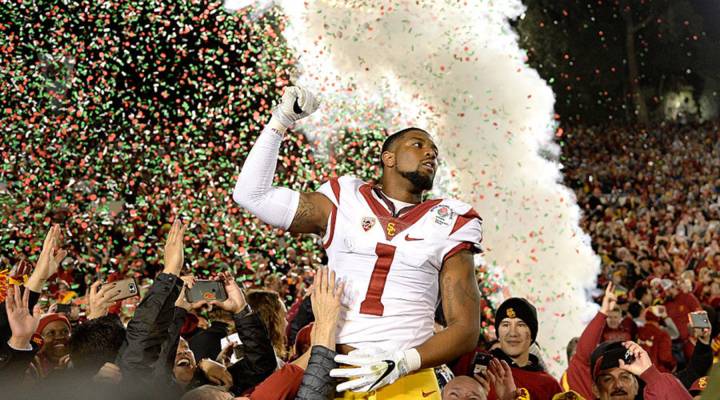
It’s not the holidays without 40 college football bowl games
It’s not the holidays without 40 college football bowl games

Brought to You By is our series about all the stuff that’s become part of the culture and of the economy. Where did they come from and who thought of them?
For many people, gathering around the TV and watching college football is as much a part of New Year as watching the ball descend in Times Square or eating black-eyed peas in the South.
But there weren’t always 40 bowl games. And the games aren’t named after fruits and flowers anymore. So, how’d we get here?
Remember that 1985 Orange Bowl game? New Year’s Day, the University of Oklahoma against the University of Washington, the Sooner Schooner coming onto the field before a field goal … no? Me neither. (I was 3 at the time).
But if you were watching, you might remember this Delta Airlines commercial.
Long before goofy commercials and New Year’s college football bowl games, in fact, on Jan. 1, 1902, the new president of the Tournament of Roses Parade had an idea. He decided Pasadena, California, would stage a college football game to drum up tourism in the area. Other cities liked the idea and followed suit. Rob Baumann, professor of economics at College of the Holy Cross, said these games used to generate revenue for small communities.
“A lot of bowls were formed by local nonprofit tourism and commerce committees of cities so that they could promote the area and they could invite people from out of town, which were the teams, the staffs and all the fans,” he explained.
In fact, we didn’t call them bowl games until 1923, when the game first moved to Pasadena’s famous Rose Bowl stadium.
In the 20s and 30s, these “bowl games” became popular on the radio, with plenty of sponsors and commercials. But on New Year’s Day, 1952 — exactly 50 years after the first game of its kind — everything changed: the first Rose Bowl was televised nationally. There was no going back.
“New Year’s Day was a day when you watched bowl games with your dad and ate potato chips and California dip,” said Michael Oriard, the starting center for Notre Dame in the 1969 Cotton Bowl between the Fighting Irish and the Texas Longhorns. He’s author of “Bowled Over: Big-Time College Football from the Sixties to the BCS Era.”
“When I grew up, there were four bowl games: the Orange, Sugar, Cotton and Rose Bowl,” Oriard said. “It was understood in the context of the struggle to keep college football in proper perspective.”
Today, college football is a multibillion-dollar business, and it’s not four games on New Year’s Day. It’s 40. They start Dec. 16 and last into the second week of January.
David Carter, executive director of the University of Southern California’s Sports Business Institute, said that since the 1980s, there’s been one big reason for that.
“I think you then saw the cable universe explode; it’s very vast and they needed programming,” he said. One network in particular is hungry for content. “You have to look at the amount of bandwidth ESPN has,” he explained. “They’ve got programming to fill.”
ESPN and ABC will broadcast 35 of the 40 bowl games this year. Like the DXL Frisco Bowl, which aired on Dec. 20.
I visited a Buffalo Wild Wings in Austin, Texas, where the game was on a couple of TVs. Nobody was watching. Now, it wasn’t a great game, but it was a bowl game, nonetheless.
So is college football serving up too many bowls?
Not according to Wright Waters, executive director of the Football Bowl Association.
“If you’re coming from the position of, ‘I want the bowls to be part of a championship,’ then, yeah,” Waters said. “But if you’re coming from the position of opportunities for student athletes, I’m not sure that argument holds water.”
The players get a swag bag and a few extra weeks of practice to show their talent to NFL scouts, but they’re not getting paid.
Baumann at College of the Holy Cross said the local communities are no longer getting much out of these bowls anymore, either.
“This does not support the local economy,” he said. “And that picture is somewhat getting worse as the attention gets focused to national TV audiences as opposed to attendance in the seats.”
It’s all a far cry from New Year’s Day in 1902, when Pasadena officials just wanted folks to come out to their little village’s floral festival and maybe watch a football game in passing.
People can still watch the Rose Bowl on New Year’s Day, but the final college football rankings won’t come out until a week later on the night of Jan. 8.
| 150 years of college football |
| ESPN airs the college football championship 14 different ways |
| Players skipping bowl games reignites debate about college athlete compensation |
There’s a lot happening in the world. Through it all, Marketplace is here for you.
You rely on Marketplace to break down the world’s events and tell you how it affects you in a fact-based, approachable way. We rely on your financial support to keep making that possible.
Your donation today powers the independent journalism that you rely on. For just $5/month, you can help sustain Marketplace so we can keep reporting on the things that matter to you.


















